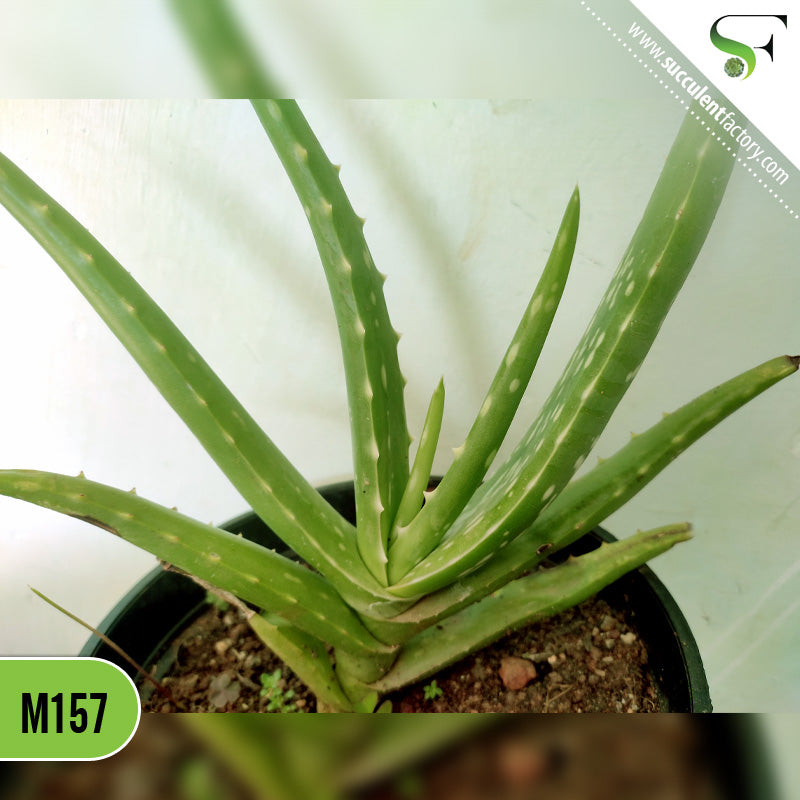Aloe Vera
Aloe Vera
Couldn't load pickup availability
Aloe Vera (Aloe barbadensis miller) Detailed Description:
Aloe vera is one of the most well-known and widely used succulent plants, renowned for its medicinal and cosmetic properties. This plant has thick, fleshy leaves filled with a clear gel that has soothing, healing qualities, especially for skin conditions such as burns and cuts. Aloe vera is an easy-to-grow plant, both indoors and outdoors, with its long, green, and serrated leaves forming a rosette shape. It is an excellent addition to any garden or home due to its low maintenance and multiple uses.
Propagation:
Aloe vera can be propagated by offsets or pups, which it produces readily, and by seeds, though the latter is a slower method.
-
Offsets (Pups):
- Aloe vera typically produces many pups or small offshoots around the base of the parent plant.
- To propagate, carefully remove the pup using a clean, sharp knife or by hand, ensuring the pup has roots attached.
- Allow the pup to dry for 1–2 days to form a callous over the cut surface before planting it in well-draining soil.
- Place the pup in a bright area, water lightly, and it should root within 2–4 weeks.
-
Seeds:
- Propagating Aloe vera from seeds is more time-consuming. Plant the seeds in a succulent soil mix, keeping them slightly moist and in a warm, bright location.
- Germination typically takes about 2–4 weeks, but it can take much longer to reach a mature size.
Sunlight Requirement:
- Full Sun to Partial Shade: Aloe vera thrives in bright light. Ideally, it should be placed in a spot where it receives at least 6 hours of sunlight daily. Full sun enhances its growth, but in very hot climates, some afternoon shade is beneficial to prevent sunburn.
- If grown indoors, place Aloe vera near a south- or west-facing window to ensure it receives enough light. If the plant is not receiving enough sunlight, it will grow leggy and stretch out.
Soil Preparation:
- Well-Draining Soil: Aloe vera requires well-draining soil to prevent water from pooling around the roots, which can lead to root rot. A cactus or succulent potting mix works best, or you can create your own mix by combining regular potting soil with sand or perlite.
- If planting outdoors, ensure the soil is sandy or loamy, and avoid planting in heavy, clay soils that retain water.
Watering:
- Minimal Watering: Aloe vera is drought-tolerant and prefers infrequent watering. During the growing season (spring and summer), water thoroughly but allow the soil to dry out completely between waterings.
- In the winter, when Aloe vera enters dormancy, reduce watering to once every 3–4 weeks. Overwatering is a common mistake with Aloe vera and can cause root rot, so it’s important to let the soil dry out between waterings.
Propagation Recap:
- Method: Offsets (pups) or seeds
- Success Rate: High with pups
- Time to Root: 2–4 weeks for pups
Hashtags:
#AloeVera #MedicinalPlants #AloeCare #SucculentPropagation #HealingPlants #NaturalRemedies #DroughtTolerantPlants #FullSunPlants #SucculentGarden #IndoorSucculents #Xeriscaping #AloeGel #LowWaterPlants #SucculentFactory #SkincarePlants #WaterwiseGardening #AloeLovers
Aloe vera is not only a functional and beneficial plant but also a beautiful, low-maintenance addition to your home or garden, making it a must-have for succulent enthusiasts and health-conscious individuals alike!
Propogation
Propogation
Plant Care Guide
Plant Care Guide
Merchandising tips
Merchandising tips
Share


